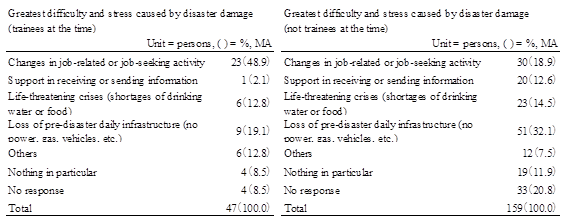JILPT Research Report No.155 Summary
The Great East Japan Earthquake and Human Resource Development Facilities:
Records from Disaster Response to Recovery and Reconstruction (JILPT, Compilation of the Results of the Project to Record the Great East Japan Earthquake No.2) (March 2013)
March 21, 2013
Summary
Research Objective
To record the state of disaster damage and response, as well as efforts for post-disaster recovery and reconstruction conducted to date by Polytechnic Centers and other vocational ability development facilities ("Centers"), mainly in the areas affected by the Great East Japan Earthquake ("the disaster").
Research Method
Interview survey + Questionnaire surveys
Major Findings
When the disaster struck, a total of more than a thousand people were working or taking training in the nine Centers in the affected areas. Although buildings, facilities and equipment were massively damaged by the earthquake and tsunami, human casualties were successfully prevented. The main reason why this was possible and an early resumption of vocational training could be achieved was that the Centers are places where practical vocational skills and technology are taught, and were therefore equipped with both human and material resources. When the disaster struck, the damage caused different levels of difficulty and stress for those who were receiving vocational training at the Centers (trainees at the time), compared to those who were working in companies and were not trainees at the Centers. Specifically the trainees appear to have obtained information more accurately and acted more calmly. This is thought to reflect the fact that the trainees at the time could see employees of the Centers making use of manufacturing expertise and skills to deal with problems like damage to buildings and property, breakdowns in telecommunications systems, and others caused by the disaster, and were able to evacuate under rational guidance of collective action from the Center employees. Moreover, there were hardly any cancellations of tentative job offers for the trainees that had been decided before the disaster, and the rate of employment at the Centers had recovered to normal levels by about two months after the disaster.
Figure

![]() Expanded view
Expanded view
* If link does not expand, please click again.
Policy Implications
- Manufacturing skills are important and indispensable for the safety and security of society.
- Training in operating heavy construction machinery for the removal of rubble, and special education in decontamination, both conducted by the Centers as displaced worker training, are expected to be effective in quickening the reconstruction of the region and promoting the re-employment of jobless workers.
- For disaster victims connected with the nuclear accident, urgent measures to stimulate motivation for re-employment must be drawn up, while considering the effects of compensation payments.
Policy Contribution
Suggestion for measures for the recovery and reconstruction of disaster-affected areas through displaced worker training.
Contents
- Cover – Preface – Authors – Contents
-
Part I Outline of the Survey
-
Part II Results of Interview Survey
-
Part III Results of Questionnaire Surveys with the Miyagi Polytechnic Center (partial) (rough aggregates)
- Part IV Additional Information and Summary
-
Appendices
Research Categories
Project Research “Research on Strategic Labor/Employment Policies for Non-regular Workers”
Subtheme "JILPT Project for Survey Research on Recovery and Reconstruction, Employment and Labor following the Great East Japan Earthquake (Project to Record the Great East Japan Earthquake)"
Research Period
FY2012
Authors
- Mari OKUTSU
- Project Researcher, The Japan Institute for Labour Policy and Training
- Seiji KOMATA
- Research Assistant, The Japan Institute for Labour Policy and Training

